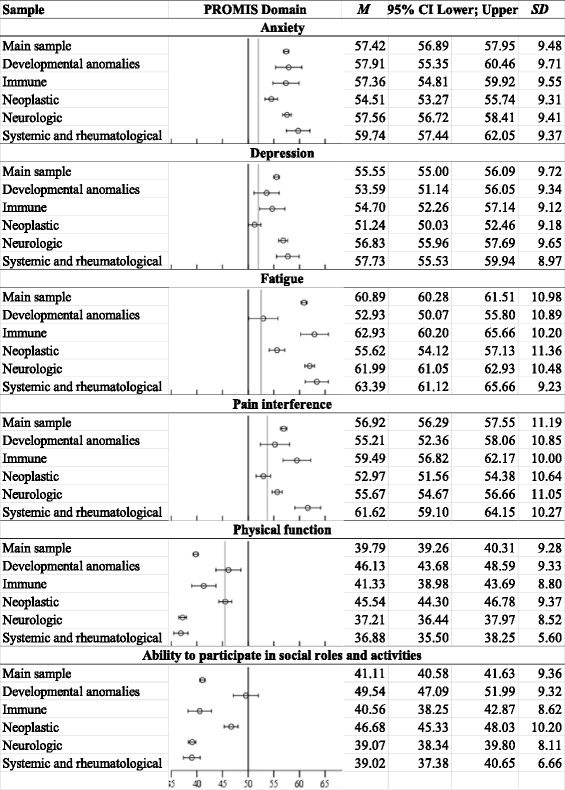Health-related quality of life among adults with diverse rare disorders
- PMID: 29212508
- PMCID: PMC5719717
- DOI: 10.1186/s13023-017-0730-1
Health-related quality of life among adults with diverse rare disorders
Abstract
Background: Twenty-five to 30 million Americans live with a rare disease (RD) and share challenges unique to RD. The majority of research on RDs has focused on etiology, treatment and care, while the limited health-related quality of life (HRQL) research has been restricted to single RDs, small samples, or non-validated measures. This study reports HRQL among adults with diverse RDs, and compares their scores to those of the U.S. population and people with common chronic health conditions.
Methods: We conducted a cross-sectional survey of adults living in the U.S. diagnosed with any RD. Participants were recruited through RD organizations and completed the online survey between December 2016 and May 2017 (n = 1218). HRQL was assessed using the standardized Patient-Reported Outcomes Measurement Information System (PROMIS). RDs were classified into categories defined by Orphanet. Means and 95% confidence intervals were calculated for the main sample and for RD categories and were compared to published U.S. population norms and common chronic disease norms. Intercorrelations were conducted between HRQL, demographics, and RD experiences.
Results: When compared to the norms for the U.S. population and for those with common chronic diseases, mean HRQL scores were significantly poorer across all six PROMIS domains for the main sample, and were usually poorer when analyzed by sub-sets of specific RD classifications. People with rare systemic and rheumatologic, neurological, and immune diseases had the poorest HRQL. Participants had poorer HRQL if they had multiple RDs, lower income, were female, or older. Having symptoms longer was associated with worse HRQL, however, having a formal diagnosis longer was associated with better HRQL.
Conclusions: This study is the first to examine HRQL in a large, heterogeneous sample of RDs using validated measures. There is a significant disparity in HRQL among people with RD compared to the general population and people with common chronic diseases. Poor HRQL could be attributed to challenges accessing diagnoses, medical information, treatment, psychosocial support, and coping with stigma and uncertainty. As most individuals with RDs will not be cured in their lifetimes, identifying ways to improve HRQL is crucial to patient-centered care and should be a funding priority.
Keywords: Anxiety; Depression; PROMIS; Quality of life; Rare disease; Rare disorder.
Conflict of interest statement
Ethics approval and consent to participate
The Oregon State University Institutional Review Board approved study protocols and provided ethical oversight. Participants read a consent document explaining the study. Because a signature would be the only record linking the participants’ identity to the survey, a waiver of documentation of consent was issued.
Consent for publication
Not applicable.
Competing interests
The authors declare that they have no competing interests.
Publisher’s Note
Springer Nature remains neutral with regard to jurisdictional claims in published maps and institutional affiliations.
Figures

References
-
- National Institutes of Health, Genetic and Rare Diseases Information Center: FAQs About Rare Diseases. https://rarediseases.info.nih.gov/diseases/pages/31/faqs-about-rare-dise.... Accessed 27 Oct 2017.
-
- Orphanet: About rare diseases. http://www.orpha.net/consor/cgi-bin/Education_AboutRareDiseases.php?lng=EN. Accessed 24 Nov 2017.
-
- Limb L, Nutt S, Sen A. Experiences of rare diseases: an insight from patients and families. Rare disease UK. 2010. https://www.raredisease.org.uk/media/1594/rduk-family-report.pdf. Accessed 10 Apr 2016.
-
- EURORDIS: Rare diseases: understanding this public health priority. 2005. http://www.eurordis.org/IMG/pdf/princeps_document-EN.pdf. Accessed 9 July 2017.
MeSH terms
Grants and funding
LinkOut - more resources
Full Text Sources
Other Literature Sources
Medical
Research Materials
Miscellaneous

